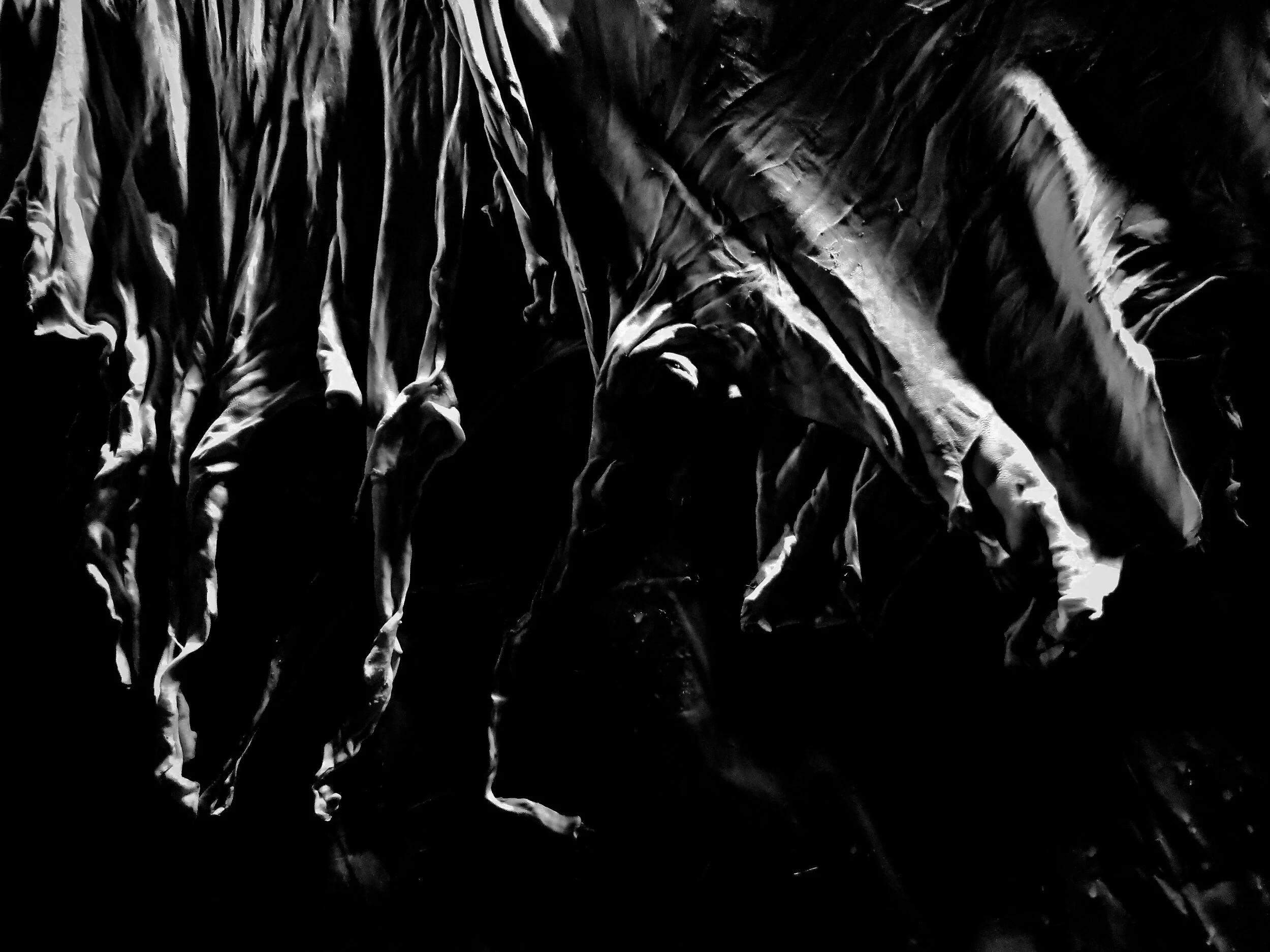
About
‘Skin, skinning, skinned’ is a parchment-making project that utilises skin sourced directly from marsupial roadkill in north-west Tasmania. While the practice is ‘trauma-driven’, engaging as it does with death, the silenced, the peripheral and the abject, it has also become a process of discovery and revelation, ‘intimately entwined with the other’, and akin to an unspoken agreement that signals due care and an understanding of the cyclical continuum between life and death, self and Other.
Works on, with and about skin include installation, photography and illumination. Other skin projects are in the pipeline, including a curated group exhibition of works on parchment.
Read more about the whys and hows of this project or scroll to view some of the works created to date.

Skin series
The ‘skin’ photographic series was developed during a two-week mentorship with Pergamena, professional parchment-makers in New York. I was drawn to the shape-shifting, pliable forms of the skins being processed inside the tannery. In making these images, I wanted to capture the fluidity of these skins, their fragility and vulnerability, as well as the paradox inherent to the whole skinning/parchment-making process: violent and brutal, but also gentle and refined.
Works on parchment
‘Foxes and Crows’ – an illumination
Artist: Lynne Gray
Wallaby parchment, egg tempera, gold leaf, 15cm x 15cm.
I collaborated with artist Lynne Gray to create something on a piece of wallaby parchment for a talk I was giving at the Ian Potter Museum of Art. Lynne chose to paint ‘Foxes and Crows’, from the 13th century Ashmole Bestiary, upon a piece of parchment from an older female wallaby from the Central Highlands. In the image, several foxes are ‘playing dead’ in the grass, hoping to catch out the crows hovering hungrily over them. Upon first sight, though, the illustration prompts a much more familiar and geo-contemporary memory: the crows that hover over roadkill in the Australian bush.
‘Mask, mimicry, mimesis’ - possum parchment, Japanese silk thread, dress pins
‘Dress for the departed’
‘Dress for the Departed’ is inspired by those liminal rites of passage, where offerings to the dead ensure a safe and comfortable afterlife. The many words of loss and lack in my grandmother’s letters inspired the making of this dress. Claims of ‘I have nothing to wear’, I’ve sold already I could’, ‘I only have galoshes to put on’, ‘I have no underwear left’, ‘I literally have nothing’, and so on, prompted the idea of gifting her something that she could wear in the afterlife. But it wasn’t only these lines that inspired. In the two pre-war photographs I inherited, Zosia is impeccably dressed – a tailored blouse and skirt in one, and in the other a beautifully fitted coat, cloche hat, clutch purse and ‘heels’ expose her as a fashionable woman, someone of elegance and taste. It seemed fitting, then, to offer this ghost something that acknowledged where she had come from and all she had lost.
The material used – deer parchment, muslin, Japanese silk and Irish linen threads, cornstarch and beeswax – is specific to an inherited and embodied haunting and woundedness. The garment and the ritual of its making is also highly symbolic to family, past and present. For example, Japanese silk thread and vintage Irish linen thread symbolise my own diverse familial heritage – the majority of ancestors on my mother’s side were Irish; my grandson is Japanese. Stitching the dress with these threads is a way of welcoming Zosia into the family and honouring her memory as ‘one of us’.
‘phylactery’
‘phylactery’ draws on the concept of the ‘memory wall’, traditionally used as a medium to memorialise victims of a traumatic event, as a way of articulating the fragmentary and wounded nature of my grandmother’s letters. In name, it draws inspiration from both the Jewish tradition of wearing leather boxes that contain parchment scrolls inscribed with sacred verses from the Torah, as well as its derivation from the Ancient Greek phylacterion, meaning ‘to guard, protect’, as in the wearing of an amulet. As a sign of remembrance, and applying this notion of the ‘sacred verse’ to my grandmother’s words, a line or word from her letters has been printed on each piece of parchment. This is then threaded with raw Japanese silk and suspended from the ceiling. The threads, although single strands attached to each individual piece of parchment, fall in a tangle on the floor, not only hinting at the interconnected and intergenerational nature of this wound, but also exploring a beyond literality of writing, words and meaning via these suspended and entangled non-texted threads and lines.
In keeping with the notion of remembering, and to encourage a beyond-the-surface thinking, qr codes are incorporated into the installation. Each code, when scanned, reveals an image of one of the animals I’ve worked with, pre-skinning. In this way, a kind of pre-identification, pre-memory, post the skin/parchment process is enabled.

Undertaking a mentorship in New York with professional parchment makers, Pergamena, really helped in my understanding of how to work with skin. I’ve also received a huge amount of help from my dear friend, Neil Thorne. Neil, born and bred in north west Tassie, first taught me how to skin an animal and has been my bona fide skinning partner ever since. Thanks, too, to the Tasmanian Department of Primary Industries, Parks, Water and the Environment for granting me the necessary permits to work with this wildlife.
© All text and images copyright Grace Pundyk 2019































